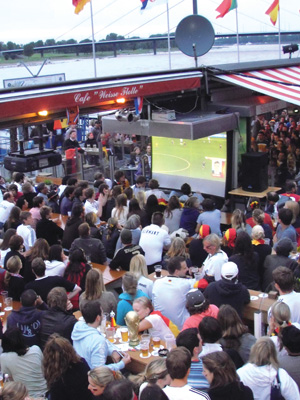ON A RECENT European jaunt, the anti-man-about-town infiltrated Düsseldorf, Germany, just in time for the World Cup. Since I grew up watching German soccer on PBS, the scenario functioned as a catalyst for some good old-fashioned self-discovery and reflection.
As a child in the late ’70s, I became particularly enamored with a now-legendary show called Soccer Made in Germany. Each hour-long show reprised news, games and highlights from the German Bundesliga. Many of us partly learned how to play soccer by watching that show.
The announcer, a colorful Brit named Toby Charles, was sort of like our teacher and our uncle at the same time. With him as our guide, we first learned about teams like Bayern Münich, Hamburg SV and Eintracht Frankfurt. In San Jose, the show was on Channel 9, and by the time I was 8 years old, I was familiar with the town of Düsseldorf. It was just a fun word to say.
These days, Düsseldorf is the capital of North Rhine-Westphalia, Germany’s most populous state, with 18 million people. The city is one of those off-the-radar places most Americans wouldn’t normally visit, but it has art, shopping, cuisine and music, with old and new architecture—only on a somewhat smaller scale than the more heavily trafficked German cities.
In just 15 minutes, an easy public transportation system takes people from the airport to the city center. The historical Old Town area (Altstadt) features at least 100 bars, restaurants, shops and outdoor cafes of seemingly every nationality. Strangely, the city’s most upscale hotel, the Breidenbacher Hof, is the only one in Germany with a plastic-surgery clinic attached to it. The accommodation is frequented by travelers from the Middle East, usually primed for shopping outside on Königsallee, or “the Kö” for short. The city also boasts a mile of beer gardens along the Rhine River, an annual outdoor book fair, a definitive cream of mustard soup and even a Neanderthal Museum. I couldn’t go wrong.
And as one would expect, soccer is an integral part of the social fabric. Each and every place with outdoor seating offered televisions for the World Cup. The German black, red and gold colors were ubiquitous, which was fun to witness, because it didn’t use to be that way.
Germany hosted the last World Cup, in 2006, and during that tournament, an unprecedented cultural shift took place across the entire country. A fun and peaceful new brand of German flag-toting patriotism enveloped the nation. During previous decades, the German people usually felt discouraged to display national flags for any reason whatsoever. They felt conditioned not to openly show pride in their own country, or not to behave in any sort of fashion that could be interpreted as nationalistic, due to the country’s sinister past. As simplistic as this sounds, the 2006 World Cup changed all of that. Gone was the stereotypical wooden, humorless German. Flags, colors and paraphernalia exploded everywhere. People painted their faces, and the nation appeared to be in a much better mood. This is a perfect example of why the World Cup is the greatest show on earth. According to the Germans who spoke to me, no other event would possibly have caused that to happen.
In Düsseldorf, when this year’s World Cup began, there were Irish, Brits, Germans, Italians, Africans, Middle-Easterners and many others milling about all over Altstadt. A Brazilian samba procession snaked its way down the cobblestone path—the same people waving both Brazilian and German flags. An oompah band pounded out tunes around the corner. I saw national team shirts from at least a dozen countries. When England played the United States, I slithered into a local pub to watch the game and cheer on the United States. The Germans I met were also rooting for America in that game.
That U.S. game put everything into perspective. I grew up in San Jose watching Soccer Made in Germany. Now I was in Germany watching soccer made in America. The cycle was complete. And Düsseldorf is still a fun word to say.




